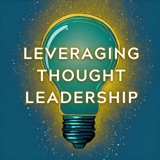
Leveraging Thought Leadership
Peter Winick and Bill Sherman
Podcast
Episodes
Listen, download, subscribe
Bridging the Gap Between Academia and Industry in STEM | Dr. Amanda Diekman and Jayshree Seth | 565
In this episode, we dive into the often-discussed but seldom addressed divide between academics and practitioners in the STEM (Science, Technology, Engineering, and Mathematics) field. We welcome two esteemed guests: Dr. Amanda Diekman, Professor of Psychological and Brain Sciences and Associate Vice Provost for Faculty and Academic Affairs at Indiana University, and Jayshree Seth, Chief Science Advocate and Corporate Scientist at 3M. Dr. Diekman acknowledges the existence of a gap between academia and industry, suggesting that it persists partly because people believe it does. However, she emphasizes that the divide can be bridged through effort, communication, and setting clear expectations. The most immediate impact of academic work is when students apply it in their careers, indicating a strong need for better alignment between academic research and industry practice. Jayshree Seth uses the metaphor of "paths not taken" to explain the academic-practitioner divide. She points out that when people stick to the familiar, the less-traveled routes become increasingly invisible. To bridge the gap, individuals must step out of their comfort zones and embrace new approaches, even if it means learning new rules and navigating uncharted territory. Jayshree and Amanda share a common interest in understanding why women, who earn STEM degrees, often do not pursue careers in STEM. Jayshree approached this issue from a social science perspective, seeking ways to ensure persistence among women in STEM fields. Amanda, with a background in gender roles and representation, found stability in the gender distribution within STEM unexplained by conventional narratives. Their collaboration aimed to identify and address the signals that deter women and minorities from engaging with STEM. Jayshree's role as Chief Science Advocate at 3M emerged from the company's efforts to understand public perception of science, which revealed that many people believed science had little impact on their lives. This realization motivated her to advocate for science and connect with like-minded researchers like Amanda. Amanda's research on gender roles and communal goals resonated with Jayshree's experience, leading to their collaboration. Amanda and Jayshree conducted a study to examine how goal congruity, the alignment between personal goals and workplace or academic values, affects students' engagement in STEM. They focused on communal goals, recognizing that a lack of context, collaboration, and empowerment might deter underrepresented groups. The study sought to document the psychological benefits of nudging students toward a purpose-driven approach in STEM, highlighting the need to shift the culture to foster inclusion and belonging. Jayshree identifies three critical areas where communal goals play a role in STEM: contextualization, collaboration, and empowerment. She shares her journey of feeling out of place in a male-dominated lab, only to discover the importance of her work later. At 3M, she found these communal goals embraced, contributing to a more inclusive environment. The PRISM (Purpose Reflection in STEM Modalities) project is an effort to provide practical tools for STEM faculty to create assignments that encourage students to reflect on their purpose and engage in meaningful conversations. This initiative, funded by 3M, aims to bridge the gap between academia and industry, promoting STEM equity and supporting minoritized talent pipelines. Both Amanda and Jayshree share their visions for the future. Jayshree hopes to see the PRISM curriculum become mandatory in STEM classes, fostering a sense of belonging and encouraging students to align their goals with communal values. Amanda envisions a broader cultural shift that creates more space for diverse values and perspectives in STEM, ultimately leading to increased retention and success among faculty and students alike. Join us as we explore these critical topics and unc
Leveraging Thought Leadership RSS Feed

